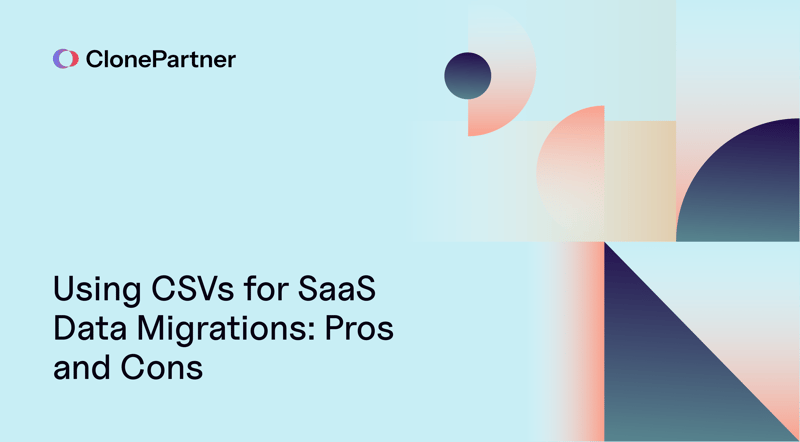
At ClonePartner, we’ve managed countless SaaS data migrations for companies across various sectors. Our experience spans:
- Helpdesk migrations for platforms like Zendesk, Freshdesk, HappyFox, Help Scout, HubSpot Service Hub, and Gorgias.
- CRM migrations involving HubSpot, Salesforce, Close, and Pipedrive.
- Ticketing system migrations for Jira and Linear.
One of the most common questions we get is: “What’s the best way to extract data for a SaaS data migration?” In this post, we’ll break down the different options—CSVs, APIs, and JSON—and help you determine the best choice for your migration.
Summary of Data Migration Methods
In a nutshell, here’s how we summarize the main options:
- CSV: Fast but limited. Prone to errors.
- APIs: Slower but thorough. Error-free. “Clean data in, clean data out.” With our experience handling 300+ APIs at Truto, we highly recommend this method.
- JSON: Fast and comprehensive, though less well-known. While faster than both CSVs and APIs, JSON exports can occasionally lack completeness.
Now, let’s dive deeper into each method to see which one suits your SaaS data migration needs best.
CSVs for SaaS Data Migrations
Skills Required
- Data wrangling: Mastery of spreadsheet functions like VLOOKUP, HLOOKUP, and pivot tables is often necessary.
- Attention to detail: You’ll need to meticulously map fields and ensure columns are correctly titled for a seamless migration.
Time Commitment
Preparing a CSV can take hours, largely due to the need for precise formatting based on the requirements of the target SaaS application. For instance, during a HubSpot import, we found that even with extensive prep, aligning the data correctly took considerable time.
Pros
- Ease of access: Most SaaS platforms allow easy download and upload of CSVs.
- Universal support: CSV uploads are supported by nearly all SaaS platforms.
Cons
- Limited data scope: Important data such as emails, calls, notes, and comments are often excluded due to the size and complexity of the CSV file.
- Time-consuming: For large datasets, both downloading and uploading can be slow.
- Data wrangling challenges: Formatting the CSV correctly can be tedious, especially if errors arise during the import process.
- Error-prone: SaaS platforms may return errors that take time to debug, often requiring expertise.
APIs for SaaS Data Migrations
Skills Required
This is the simplest option. Typically, all you need to do is connect the source and destination accounts via an API. In some cases, you may need to generate an API key, but this process is straightforward. If you’re looking for the easiest and most automated migration method, APIs are your best bet.
Time Commitment
The total time depends on the rate limits of the source and destination APIs. Rate limits refer to the maximum number of requests that can be made to the API within a set time frame, which can slow down large migrations. For example, an API with a rate limit of 100 requests per minute can only process that number of records in the same time period.
Pros
- Simplicity: Connect your accounts and start migrating.
- Comprehensive: APIs often allow the migration of all data types, including emails, conversations, private notes, comments, and users. At ClonePartner, we often combine API-based migrations with CSV or JSON to ensure no data is left behind.
Cons
- Rate limits: Strict API rate limits can slow down the migration process compared to CSV or JSON methods.
JSON for SaaS Data Migrations
Skills Required
While a JSON data dump does require some data manipulation, it’s easier than working with CSVs. JSON files can be handled programmatically, and ClonePartner’s engineering team handles all the data wrangling for you. Your only task is to generate the JSON export from the source SaaS application and share it with us.
Time Commitment
While JSON exports are quick to generate from the source, they can’t be directly uploaded to the destination SaaS application. The data needs to be pushed through the destination’s API, subjecting the migration to the same API rate limits. However, thanks to our engineering expertise, most JSON-based migrations at ClonePartner are completed over a weekend.
Pros
- Fast extraction: JSON files are quick to generate from most SaaS platforms.
- Comprehensive: In most cases, JSON exports include all necessary data.
- Code-friendly: JSON files are easy to manipulate programmatically, making the data wrangling process smoother. Our engineering team at ClonePartner takes care of this for you.
Cons
- Incomplete data: Some data might be missing from the JSON export. To fill in these gaps, we often supplement JSON migrations with API requests to ensure a complete data transfer.
Our recommendation
We recommend using a combination of APIs and JSON to complete your SaaS data migration. It brings best of both worlds. It ensures that you migrate all the data in the least amount of time without any errors.